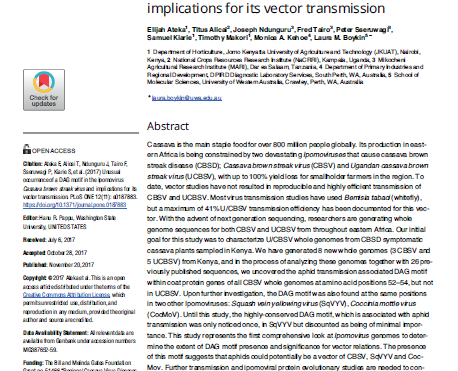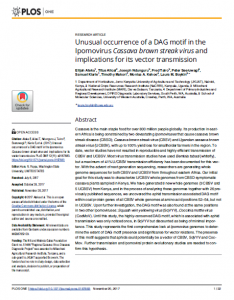Cassava is the main staple food for over 800 million people globally. Its production in eastern Africa is being constrained by two devastating Ipomoviruses that cause cassava brown streak disease (CBSD), Cassava brown streak virus (CBSV) and Ugandan cassava brown streak virus (UCBSV), with up to 100% yield loss for smallholder farmers in the region. To date, vector studies have not resulted in reproducible and highly efficient transmission of CBSV and UCBSV. Most virus transmission studies have used Bemisia tabaci (whitefly), but a maximum of 41% U/CBSV transmission efficiency has been documented for this vector. With the advent of next generation sequencing, researchers are generating whole genome sequences for both CBSV and UCBSV from throughout eastern Africa. Our initial goal for this study was to characterise U/CBSV whole genomes from CBSD symptomatic cassava plants sampled in Kenya. We have generated 8 new whole genomes (3 CBSV and 5 UCBSV) from Kenya, and in the process of analysing these genomes together with 26 previously published sequences, we uncovered the aphid transmission associated DAG motif within coat protein genes of all CBSV whole genomes at amino acid positions 52–54, but not in UCBSV. Upon further investigation, the DAG motif was also found at the same positions in two other Ipomoviruses: Squash vein yellowing virus (SqVYV) and Coccinia mottle virus (CocMoV). Until this study, the highly-conserved DAG motif, which is associated with aphid transmission was only noticed once, in SqVYV but discounted as being of minimal importance. This study represents the first comprehensive look at Ipomovirus genomes to determine the extent of DAG motif presence and significance for vector relations. The presence of this motif suggests that aphids could potentially be a vector of CBSV, SqVYV and CocMov. Further transmission and ipomoviral protein evolutionary studies are needed to confirm this hypothesis.
Region: Africa
Date published:
2017
Published by:
PLOS One
Type of resource:
Journal article
Resource topic:
Cassava
Project/Programme: Not specific
Pest/Disease: Cassava brown streak virus
Pages:
22
File type:
External link (5.9 MB)




